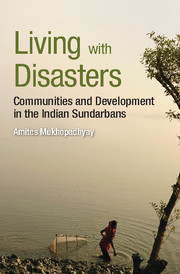Book contents
- Frontmatter
- Dedication
- Contents
- Maps and Illustrations
- Tables and Charts
- Glossary
- Acronyms
- Acknowledgements
- Note on Transliteration
- Maps
- Illustrations
- Charts
- 1 Introduction
- 2 From Wasteland to Wonderland: The Making of a Heritage Site
- 3 Governing the Sundarbans Embankments Today: Between Policies and Practices
- 4 Treading a Fine Path between River and Land: Livelihoods around Embankment
- 5 Beldars, Embankment and Governance: Question of Aboriginality Revisited
- 6 Catching Prawn, Endangering Embankments: Sustainability-Unsustainability Rhetoric
- 7 Conclusion
- Bibliography
- Index
1 - Introduction
Published online by Cambridge University Press: 05 March 2016
- Frontmatter
- Dedication
- Contents
- Maps and Illustrations
- Tables and Charts
- Glossary
- Acronyms
- Acknowledgements
- Note on Transliteration
- Maps
- Illustrations
- Charts
- 1 Introduction
- 2 From Wasteland to Wonderland: The Making of a Heritage Site
- 3 Governing the Sundarbans Embankments Today: Between Policies and Practices
- 4 Treading a Fine Path between River and Land: Livelihoods around Embankment
- 5 Beldars, Embankment and Governance: Question of Aboriginality Revisited
- 6 Catching Prawn, Endangering Embankments: Sustainability-Unsustainability Rhetoric
- 7 Conclusion
- Bibliography
- Index
Summary
The Sundarbans embankments: Between land and water
While sitting on an embankment, I started a dialogue with Bhagirath Patra, a resident of north Kusumpur, one of the most severely affected parts of Kusumpur island, where the rivers Goira and Matla were eroding banks on the eastern and western sides, respectively (see Maps 3 and 4). Bhagirath, one of the worst victims of land erosion, was now left with less than a bigha of land where he had his house and tiny plot of paddy land. Before I could proceed to interview him, he stopped me and tried to draw my attention to the vast tract of uninhabited landmass of Prakashnagar island right across the river. Pointing towards the opposite bank, Bhagirath told me, ‘You know, we used to stay there. We had our bilan jami where the river is flowing now. You can't make out where our house was, it was far beyond the new land that has surfaced and added to the landmass of Prakashnagar. This is the fourth ring embankment that we have seen during our lifetime. Everything is gone. The river and embankment are eating into our strength’.
It would be misleading to consider Bhagirath's narrative as unusual since he shared his agony with many other Sundarbans islanders. The shape and contour of Kusumpur were changing almost every day. Standing on the embankment, it was difficult for an outsider to visualize what the island looked like in the past when the landmass on its western side extended far beyond where the river Matla was now flowing. It was even more difficult to imagine how the new land or char that had emerged out of the siltation process on the other side of the Matla could once have belonged to the people of Kusumpur. But that was how people in Kusumpur perceived their lost land. They believed that the land they lost due to continuous erosion and multiple ring embankments had contributed to the increasing landmass of Prakashnagar. But they could not call this new land their own; they were denied access to it as it belonged to a different panchayat.
As Bhagirath was talking to me, I saw Adhar Mondal, another resident of north Kusumpur walking towards us. He brought to our notice fresh breaches that had appeared in the embankment there.
- Type
- Chapter
- Information
- Living with DisastersCommunities and Development in the Indian Sundarbans, pp. 1 - 24Publisher: Cambridge University PressPrint publication year: 2016



